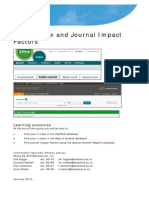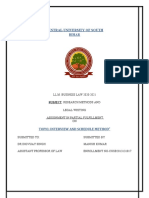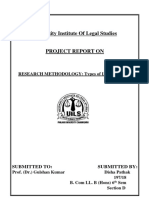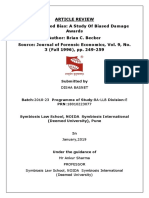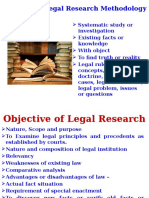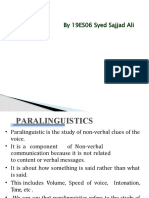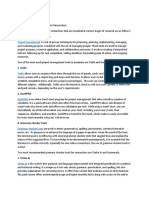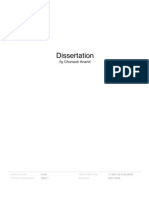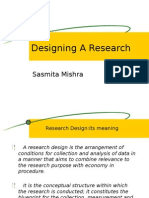0 ratings0% found this document useful (0 votes)
166 viewsResearch Design
Research Design
Uploaded by
ashwini rotheThe document discusses the concept, need, advantages, importance, and features of a good research design. It explains that a research design provides the overall plan or framework for conducting research, integrating different components in a logical way. A good design clarifies the research problem, provides guidelines for data collection and analysis, is flexible and economical, and minimizes bias. The design process involves defining the problem, assessing the value of needed information, selecting a data collection approach, choosing measurement techniques, sampling, analyzing models, and ensuring ethics. An effective design facilitates efficient research.
Copyright:
© All Rights Reserved
Available Formats
Download as PDF, TXT or read online from Scribd
Research Design
Research Design
Uploaded by
ashwini rothe0 ratings0% found this document useful (0 votes)
166 views6 pagesThe document discusses the concept, need, advantages, importance, and features of a good research design. It explains that a research design provides the overall plan or framework for conducting research, integrating different components in a logical way. A good design clarifies the research problem, provides guidelines for data collection and analysis, is flexible and economical, and minimizes bias. The design process involves defining the problem, assessing the value of needed information, selecting a data collection approach, choosing measurement techniques, sampling, analyzing models, and ensuring ethics. An effective design facilitates efficient research.
Original Description:
Research design and types
Copyright
© © All Rights Reserved
Available Formats
PDF, TXT or read online from Scribd
Share this document
Did you find this document useful?
Is this content inappropriate?
The document discusses the concept, need, advantages, importance, and features of a good research design. It explains that a research design provides the overall plan or framework for conducting research, integrating different components in a logical way. A good design clarifies the research problem, provides guidelines for data collection and analysis, is flexible and economical, and minimizes bias. The design process involves defining the problem, assessing the value of needed information, selecting a data collection approach, choosing measurement techniques, sampling, analyzing models, and ensuring ethics. An effective design facilitates efficient research.
Copyright:
© All Rights Reserved
Available Formats
Download as PDF, TXT or read online from Scribd
Download as pdf or txt
0 ratings0% found this document useful (0 votes)
166 views6 pagesResearch Design
Research Design
Uploaded by
ashwini rotheThe document discusses the concept, need, advantages, importance, and features of a good research design. It explains that a research design provides the overall plan or framework for conducting research, integrating different components in a logical way. A good design clarifies the research problem, provides guidelines for data collection and analysis, is flexible and economical, and minimizes bias. The design process involves defining the problem, assessing the value of needed information, selecting a data collection approach, choosing measurement techniques, sampling, analyzing models, and ensuring ethics. An effective design facilitates efficient research.
Copyright:
© All Rights Reserved
Available Formats
Download as PDF, TXT or read online from Scribd
Download as pdf or txt
You are on page 1of 6
Topic – Research Design – Concept, Need, Advantages, Importance &
Features of Good Research Design
CONCEPT OF RESEARCH DESIGN
The research design is an overall formulation of a research problem. It refers to the overall
strategy that you choose to integrate the different components of the study in a coherent and
logical way. It is a framework or blueprint for conducting the research. In simple words it is
the general plan of how you will go about your research. According to Smith (1976) – “A
design is a carefully arranged scheme regarding how to conduct an experiment. The design of
an experiment refers to the selection and arrangement of conditions”. According to Kerlinger
– “Research design is the plan, structure and strategy of investigation conceived so as to
obtain answers to research questions and to control variance”. The design of a study defines
the study type (descriptive, correlational, semi-experimental, experimental, review, meta-
analytic) and sub-type (e.g., descriptive - longitudinal case study), research question,
hypotheses, independent and dependent variables, experimental design, and, if applicable,
data collection methods and a statistical analysis plan. A research design will typically
include how data is to be collected, what instruments will be employed, how the instruments
will be used and the intended means for analysing data collected. A research design is a
systematic plan to study a scientific problem. A research design is the arrangement of
conditions for collection and analysis of data in a manner that aims to combine relevance to
the research purpose with economy in Procedure. The research design is a comprehensive
master plan of the research study to be undertaken, giving a general statement of the methods
to be used.
Need for Research Design
Research design is needed because it facilitates the smooth sailing of the various research
operations. It makes the research as efficient as possible by giving maximum information
with minimal expenditure of effort, time and money. For construction of a house, we need to
have a proper blueprint prepared by an expert architect. Similarly, we need a proper research
design or plan prior to data collection and analysis of our research project. Preparation of
research design should be done carefully as even a minute error might ruin the purpose of the
entire project. The design helps the researcher to organize his/her ideas, which helps to
identify and correct his/her flaws, if any. In a good research design, all the components with
each other or go together with each other in a coherent manner. The theoretical and
conceptual framework must with the research goals and purposes. Likewise, the data
collection strategy must fit with the research purposes, conceptual and theoretical framework
and approach to data analysis.
In short, the need for research design is as follows –
Provides firm foundation to the endeavour.
It reduces inaccuracy.
Helps to get maximum efficiency and reliability.
Eliminates bias and marginal errors.
Minimizes wastage of time.
Reduce uncertainty, confusion and practical haphazard related to any research
problem.
Helpful for collecting research materials.
Helpful for testing of hypothesis.
Gives an idea regarding the type of resources required in terms of money, manpower,
time, and efforts.
Provides an overview to other experts.
Guides the research in the right direction.
Smooth & efficient sailing (sets boundaries & helps prevent blind search).
Advantages of Research Design
Helps researcher to prepare himself/herself to carry out research in a proper and a
systematic way.
Ensures project time schedule.
Consumes less time.
Better documentation of the various activities while the project work is going on.
Provides satisfaction and confidence, accompanied with a sense of success from the
beginning of the work of the research project.
Helps in proper planning of the resources and their procurement in right time. Hence,
a research design is the outline, plan, or strategy that you are going to use to obtain an
answer to your research question.
Importance of Research Design
The importance of research design lies in the fact that it makes a statement of what is
to be done in order to achieve the research objectives and how it is to be done. It
furnishes the minimum information required for planning the research project. It is an
expression of what is expected of the research exercise in terms of results and the
analytical input needed to convert data into research findings. The research design
furnishes a clear idea as to the activities that would need to be undertaken in order to
achieve the research objective. It enables the researcher to have a frame of reference
and prevent the study from deviating. The research design helps in providing direction
to the computation and interpretation process to arrive at solution and
recommendations.
Features of Good Research Design
There are following feature of good research design. Which are as follows.
1.Research Design should clarify the Particular research problem.
2.It Provides guideline for specific method of data collection & Analysis.
3.Research Design should be Flexible, efficient & Economical in nature.
4.Research Design minimises Biasness of Study.
5.Research Design must support reliability of data.
Process of Research Design
The stages in the process of research design are interactive in nature and often
occur at the same time. Designing of research study follows given process.
Steps in research design :
Step 1: Defining Research Problem :
The definition of research problem is the foremost and important part of a
research design process. Defining the research problem includes supplying the
information that is required by the management. Without defining the research
problem appropriately, it is not possible for the researcher to conclude the
accurate, results. While defining research problem, the researchers first analyse
the problems or opportunities in management, then they analyse the situation.
The purpose of clarifying the research problem is to make sure that the area of
concern for research is properly reflected and management decision is correctly
described. After situation analysis, they develop a model for research which
helps in the next step which is specification of information.
Step 2: Assess the Value of Information :
When a research problem is approached, it is usually based on some
information. These data are obtained from past experiences as well as other
sources. On the basis of this information, some preliminary judgement are made
regarding the research problem. There is always a need for additional
information which is available without additional cost and delay but waiting and
paying for the valuable information is quite difficult.
For example, a car manufacturing industry may be concerned about decrease in
the sale of a particular model. A researcher will look for the solutions by
analyzing various aspects.
For this, the researcher has to continuously collect a lot of information and
needs to evaluate them by understanding their value and filtering out useless
information.
Step 3: Select the Approach for Data Collection :
For any type of research, a researcher needs data. Once, it is identified that
which kind of information is required for conducting the research, the
researchers proceed towards collecting the data. The data can be collected using
secondary or primary sources.
Secondary data is the previous collected information for some other purpose,
while the primary data is collected by the researcher especially for the research
problem.
Step 4: Select the Measurement Technique :
After collecting data, the measurement technique for the collected data is
selected. The major measurement techniques used in research are as follows :
i) Questionnaire :
Questionnaire is a formal structure which contains questions to collect the
information from the respondents regarding his attitude, beliefs, behavior,
knowledge, etc.
ii) Attitude Scales :
Attitude scales are used to extract the beliefs and feelings of the respondents
regarding an object or issue.
iii) Observation :
It is the monitoring of behaviors and psychological changes of the respondents.
It is widely used in research.
iv) Projective Techniques and Depth Interview :
Sometimes direct questions are not sufficient to get true responses from the
individuals, that is why. different approaches like depth interviews
and projective techniques are used. These techniques allow the respondents to
give their responses without any fear. Researcher neither disagrees nor gives
advice in these techniques.
Step 5: Sample Selection :
Once, the measurement technique has been selected, the next step is selecting
the sample to conduct the research. The researchers in this stage select a sample
out of the total population instead of considering the population as a
whole. Sample can be selected by using two techniques, i.e., random sampling
techniques, and non-random sampling techniques.
Step 6: Selecting Model of Analysis :
Researchers select the model of analysis or technique of data analysis, before
collecting data. After this, researchers evaluate the techniques using
hypothetical values to ensure that the measurement technique would provide the
desired outcome regarding the research problem.
Step 7: Evaluate the Ethics of Research :
While conducting research, it becomes very much necessary for the researcher
to follow ethical practices. The researches which are conducted ethically draws
interests of general public, respondents, clients and other research
professionals. Hence, it becomes the duty of the researcher to evaluate the
practices in research, to avoid any biasness on behalf of the observer and
researcher as well.
Step 8: Estimate Time and Financial Requirements :
This step is one of the most important steps in designing research. Here,
researchers use different methods like Critical Path Method (CPM) and
Programme Evaluation Review Technique (PERT) to design the plan as well as
control process and to determine the resources required.
A flowchart of these activities along with their approximate time is prepared for
visual assessment of the research process. With the help of this chart, the
researcher can find out the sequence of activities to be taken.
Step 9: Prepare the Research Proposal :
The final step in the process of research design is preparing the research
proposal. A research proposal or the research design is prepared the operation
and control of research. An effective research proposal is prepared before actual
conduction of the research.
You might also like
- 02 - Summary - Scientific Approach To Research in Physical and Management SciencesDocument1 page02 - Summary - Scientific Approach To Research in Physical and Management Sciencesvishal sinha0% (1)
- H Indexing MechanismDocument17 pagesH Indexing MechanismNitesh KrishnanNo ratings yet
- Interview MethodDocument9 pagesInterview MethodAnonNo ratings yet
- Unit-1 - Research Methodology & Fundamentals of MRDocument31 pagesUnit-1 - Research Methodology & Fundamentals of MRPrashant DubeyNo ratings yet
- Interview and Schedule MethodDocument19 pagesInterview and Schedule MethodMANISH KUMARNo ratings yet
- Research Notes 1 PDFDocument18 pagesResearch Notes 1 PDFSekar MuruganNo ratings yet
- What Is A QuestionnaireDocument5 pagesWhat Is A QuestionnaireAsmaa BaghliNo ratings yet
- Legal Research Methods AnalysisDocument10 pagesLegal Research Methods AnalysistyriciaNo ratings yet
- Research Methodology Unit - 3Document21 pagesResearch Methodology Unit - 3Vivek RoyNo ratings yet
- Chapter 3Document17 pagesChapter 3Luis OliveiraNo ratings yet
- Chap 03Document30 pagesChap 03vadla snehaNo ratings yet
- Role of Hypothesis in ResearchDocument12 pagesRole of Hypothesis in ResearchOm Prakash Choudhary100% (2)
- Conclusive ResearchDocument1 pageConclusive ResearchDeepan BaluNo ratings yet
- RM Legal Research Types Disha Pathak 197 - 18Document14 pagesRM Legal Research Types Disha Pathak 197 - 18Disha PathakNo ratings yet
- A Scientific Research Be Gins With A Single Carefully Observed Event and Progresses Ultimately To The Formulation of Theories and LawsDocument6 pagesA Scientific Research Be Gins With A Single Carefully Observed Event and Progresses Ultimately To The Formulation of Theories and LawsPayal SharmaNo ratings yet
- NTCC Final PDFDocument14 pagesNTCC Final PDFYuvraj Kanishk AryaNo ratings yet
- Shikhhaaa LRMDocument18 pagesShikhhaaa LRMRahul TambiNo ratings yet
- Legal ResearchDocument23 pagesLegal ResearchLuke OtienoNo ratings yet
- Sample Project 3 (Tanya Shukla Lot)Document20 pagesSample Project 3 (Tanya Shukla Lot)Anay MehrotraNo ratings yet
- LEC # 1 Research Methodology-An IntroductionDocument17 pagesLEC # 1 Research Methodology-An IntroductionHaleema SadiaNo ratings yet
- Review of LiteratureDocument8 pagesReview of LiteratureManar Mahmoud100% (1)
- BR Chapter 6 - Sample Design and Sampling ProcedureDocument18 pagesBR Chapter 6 - Sample Design and Sampling ProcedureAsif Islam SamannoyNo ratings yet
- Research Onion PDFDocument6 pagesResearch Onion PDFMalima TechnologiesNo ratings yet
- Article ReviewDocument11 pagesArticle ReviewDisha BasnetNo ratings yet
- Unit 3 Research DesignDocument2 pagesUnit 3 Research DesignSmarika SubediNo ratings yet
- Legal Education Assignment TopicDocument12 pagesLegal Education Assignment TopicadvocateabdulkalamNo ratings yet
- Legal Research MethodologyDocument32 pagesLegal Research MethodologyKiran KumarNo ratings yet
- Lecture 3-LITERATURE REVIEW IN RESEARCHDocument30 pagesLecture 3-LITERATURE REVIEW IN RESEARCHelowendesigns001100% (1)
- Research Methodology IntroductionDocument7 pagesResearch Methodology IntroductionDurga Prasad DashNo ratings yet
- Legal Research MethodologyDocument32 pagesLegal Research MethodologyRishabhMishraNo ratings yet
- Media Law Final DraftDocument10 pagesMedia Law Final DraftDeepak RavNo ratings yet
- Tools of Data Collection (Sadia)Document11 pagesTools of Data Collection (Sadia)Ayesha AasshNo ratings yet
- A Study of Metacognitive Skills Among Senior Secondary Students in Relation To Subject Stream and Various DemographicsDocument13 pagesA Study of Metacognitive Skills Among Senior Secondary Students in Relation To Subject Stream and Various DemographicsAnonymous CwJeBCAXpNo ratings yet
- Paralinguistics and GestureDocument14 pagesParalinguistics and GestureSyed Sajjad AliNo ratings yet
- The Effect of Visual Teaching Aids On The Students of Marathi Medium in The Subject of MarathiDocument31 pagesThe Effect of Visual Teaching Aids On The Students of Marathi Medium in The Subject of MarathiSOHEL BANGINo ratings yet
- METHODS OF DATA COLLECTION-ObsrvationDocument30 pagesMETHODS OF DATA COLLECTION-ObsrvationVijay Kumar SinghNo ratings yet
- Research MethodologyDocument2 pagesResearch Methodologyaliyi ahmedNo ratings yet
- Presentation1 (Accidental Sampling)Document40 pagesPresentation1 (Accidental Sampling)Phakdey SenNo ratings yet
- New Syllabus of Research MonographDocument1 pageNew Syllabus of Research MonographNayem MiaziNo ratings yet
- EEH - UNIT - I and IIDocument16 pagesEEH - UNIT - I and IIWilliam StainsNo ratings yet
- Most Important Online Tools For ResearchersDocument7 pagesMost Important Online Tools For ResearchersAna Mae CatubesNo ratings yet
- 13 Multi Modal Transportation of Goods Act 1993 Unit V, PPT 12Document32 pages13 Multi Modal Transportation of Goods Act 1993 Unit V, PPT 12Shaurya YadavNo ratings yet
- Research Design DefinitionDocument12 pagesResearch Design DefinitionWiz SantaNo ratings yet
- Criteria of Good Research & Problems Encountered by ResearchersDocument11 pagesCriteria of Good Research & Problems Encountered by ResearchersABITHA100% (1)
- Primary Data Collection MethodsDocument2 pagesPrimary Data Collection MethodsPoonal AsasNo ratings yet
- 3rd Sem Solved EntrepreneurshipDocument54 pages3rd Sem Solved Entrepreneurshipmounicasura100% (1)
- Preparing A VivaDocument27 pagesPreparing A VivaJabed ChoudhuryNo ratings yet
- LLM Dissertation-Chunauti Anand-TII TestedDocument107 pagesLLM Dissertation-Chunauti Anand-TII TestedAnil KumarNo ratings yet
- Types of Sampling DesignDocument8 pagesTypes of Sampling DesignRamadurga PillaNo ratings yet
- 2008 Mumbai AttacksDocument11 pages2008 Mumbai AttacksHitinNo ratings yet
- Assignment On:: Various Aspects of Court Management (Seminar Paper III) (Court & Docket Management)Document14 pagesAssignment On:: Various Aspects of Court Management (Seminar Paper III) (Court & Docket Management)Ankesh YadavNo ratings yet
- Case Study ResearchDocument23 pagesCase Study ResearchAashana AgarwalNo ratings yet
- Importance, Roles, Scope and Characteristics of ResearchDocument12 pagesImportance, Roles, Scope and Characteristics of ResearchMaricar CacaoNo ratings yet
- Essentials of A Good Research ReportDocument7 pagesEssentials of A Good Research Reportmahendrak100% (1)
- Research MethodologyDocument67 pagesResearch MethodologyatulbhasinNo ratings yet
- Difference Between Census and Sampling MethodDocument1 pageDifference Between Census and Sampling MethodNachiket ShahNo ratings yet
- Demand Estimation of Dairy Products and The Study of Distribution Network of GCMMF (Amul) - ChennaiDocument39 pagesDemand Estimation of Dairy Products and The Study of Distribution Network of GCMMF (Amul) - Chennaiknox21villeNo ratings yet
- Investigation into the Adherence to Corporate Governance in Zimbabwe’s SME SectorFrom EverandInvestigation into the Adherence to Corporate Governance in Zimbabwe’s SME SectorNo ratings yet
- Research Concept Question 1 AssignmentDocument8 pagesResearch Concept Question 1 AssignmentomondijuelNo ratings yet
- Designing A ResearchDocument9 pagesDesigning A ResearchDurga Prasad DashNo ratings yet

